One of the reasons for the current barbarians-at-the-gate problem is so many people have no consciousness of history. It is very true that one cannot understand the present if one doesn’t know what happened in the past. How could one?
Thus, many people unknowingly regard the EV as a “new” thing – and “the future” – when in fact EVs are an ancient thing.
Their problems aren’t new, either.
The electric car battery dates to circa 1859 – decades before the first internal combustion-powered engine appeared. Its inventor, a Frenchman named Gustave Trouve, bolted his battery and a small electric motor to a tricycle and – voila! – the first EV.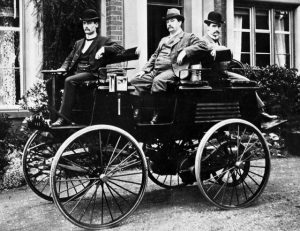
It had the market all to itself because there was no other means of getting around except getting a horse. However, it didn’t develop much of a market because it was too small and too impractical, being a three-wheeler – and not being able to go very far. The latter a problem that continues to beset four-wheeled electric cars.
The first one of those was made by a Brit – Thomas Parker – in 1884. He improved on the design of the lead-acid battery and the “dynamos” (generators) that created the electricity to recharge them.
More electric cars followed – including the German-built Flocken Elektrowagen of 1888 and then (in America) the Baker Electric Motor Vehicle Company, which built its first EV in 1889.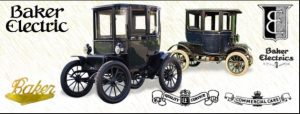
They improved on the basic concept pioneered by Trouve and Parker. They had the same desirable attributes then as now. They were simple and quiet and in those ways preferable to a horse, at least for getting around in a city. And they were preferable to the early IC cars, too – which were not simple or quiet or easy to use. You had to have the physical strength to manually crank the engine, which excluded most women from getting behind the wheel. You also had to know how to manipulate all sorts of levers, adjust spark timing and various other high-order skills which excluded lots of men.
The early IC cars also excluded most men and women who couldn’t afford one. The early IC cars were essentially hand-built, one at a time – and so very expensive relative to an EV and to a horse. 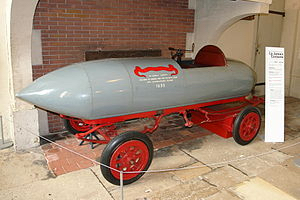
Plus, they were crude and balky and seemed to be going nowhere – and not very fast.
Here’s more history most have forgotten:
The first land-speed records were all held by EVs, up to 1899 (65.79 MPH achieved by the Belgian Camille Jenatzy driving La Jamais Contente).
High speed was also an EV forte . . .
But not for long. Literally – as well as figuratively.
The rickety little Benz “patent” Motorwagen – the world’s first production IC-powered car – arrived in 1885 and well behind the EVs that were around at the time. Like Touvre’s contraption, it was also a three-wheeler, but instead of a battery it was propelled by a single-cylinder (1 liter) combustion engine.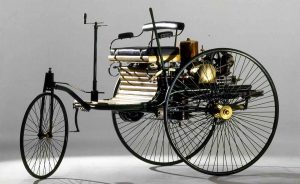
The beating heart of the future.
The IC-powered car got a late start but quickly caught up – and passed – the electric car.
Not just in speed.
In every way.
It took only 17 years for IC propulsion to go from where the EV was circa 1859 to being the holder of the new land speed record – 76.03 MPH – set in 1902 by American driver Willam K. Vanderbilt.
But speed isn’t everything – then or now. 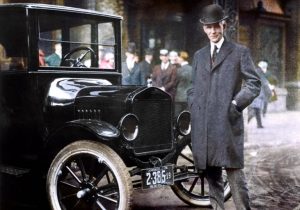
What enabled the IC car to sail past the electric car – in terms of sales – was its endurance, versatility and low cost. In these respects, the EV became the past almost as quickly as ice cream melts in the July sun.
If one lived on a farm out in the country – as most Americans still did around the time Henry Ford introduced his Model T – one lived very far from places to plug in. Many homes didn’t even have electricity – and even those that did were too far away from where the people who lived there needed to go – and get back from.
An EV wouldn’t suit.
But an IC did. In part because its fuel was portable – and easily transferable. Liquid energy that didn’t have to be pressurized to remain liquid; that was easily poured or pumped without any special equipment or precautions. This – plus the ability to go much farther without needing to refuel – literally severed the umbilical cord that tied the electric car and its owner to the city. 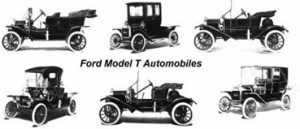
The Model T was also cheap. Almost literally dirt cheap. It got cheaper, too – with each new model year. Anyone who worked at Ford could afford a Ford. And soon, a Chevy. Or any of what quickly became an array of choices in sizes and colors and shapes that became the envy of the rest of the world.
Not only were they affordable, they were also drivable – by almost anyone, too – once Kettering invented the self-starter.
IC cars gave Americans – average Americans, not just rich Americans – unprecedented individualized freedom of movement. The freedom to go literally anywhere that wheels – their wheels – could take them. It is not going too far to say that internal combustion liberated them.
And not merely in terms of mobility. IC also gave them time – that priceless commodity none of us, no matter how much wealth we possess – can buy even a little bit more of once spent. Instead of waiting for a battery to charge one just went about one’s life. Farther – and faster and cheaper.
And now – ignorant of the history – Americans clamor for a return to the past. To re-attach the umbilical cord that once tied them to a particular place and so diminished their freedom of movement, lowered their horizons, cost them irreplaceable time and – in a very real sense – kept them on the farm.
Now it’s back to the farm. The cube farm. Face-diapered and chipped. Heads down, arms vaccinated.
But they don’t see it because they don’t remember it. And they don’t remember because they never knew about it.
. . .
Got a question about cars, Libertarian politics – or anything else? Click on the “ask Eric” link and send ’em in!
If you like what you’ve found here please consider supporting EPautos.
We depend on you to keep the wheels turning!
Our donate button is here.
If you prefer not to use PayPal, our mailing address is:
EPautos
721 Hummingbird Lane SE
Copper Hill, VA 24079
PS: Get an EPautos magnet or sticker or coaster in return for a $20 or more one-time donation or a $10 or more monthly recurring donation. (Please be sure to tell us you want a magnet or sticker or coaster – and also, provide an address, so we know where to mail the thing!)
If you’d like an ear tag – custom made! – just ask and it will be delivered.
My latest eBook is also available for your favorite price – free! Click here. If that fails, email me at [email protected] and I will send you a copy directly!


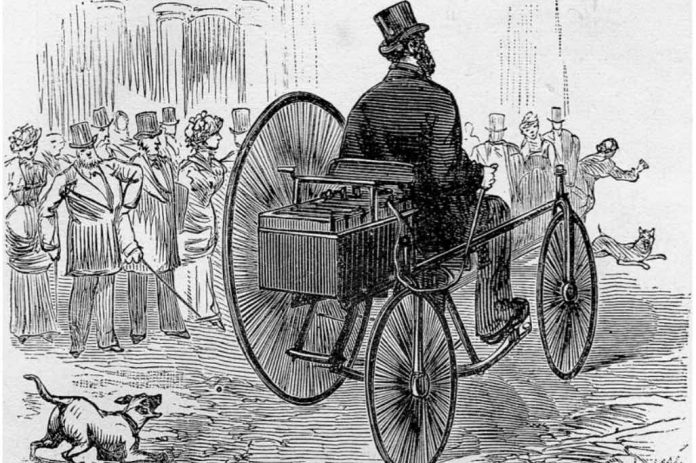









Hey Eric, great history lesson! While we’re on that subject would love to hear your take on the Stanley Steamer and other attempts at steam powered vehicles. With today’s technology I bet they could come up with a design that would warm up fast enough to be practical even in the snow belt, plus be at least as efficient as an IC engine. Could also be designed to run on diesel/number 2 oil, kerosene, propane, whatever is cheapest where you lived. Might get a short blast of high pressure steam in a collision but not any worse than a gasoline fire or lithium battery meltdown. Enquiring minds want to know 😆
I’d love to have an electric commuter vehicle, charged on a nuclear powered grid. But the TCO of an automobile is prohibitive, especially one that meets all the criteria necessary for highway permits, so I can only afford to own one vehicle. Fueling up is about the least expensive part of ownership. And besides, most of my electricity comes from natural gas and coal, so I doubt the “carbon footprint” would be much less anyway.
It would be convenient to charge at home and the office though. And the maintenance schedule for an electric motor -vs- ICE is exponentially simpler, at least in theory. I have electric motors that have been running for decades without fail, and if they aren’t abused can run basically forever, or at least until the bearings wear out (which is a fairly simple repair). Sure, that’s on a stationary object, so in an automotive environment they won’t be expected to last as long, but the point is it is possible with minimal maintenance to keep brushless motors running.
Hi RK,
You might be interested in a used Volt. The initial cost was absurdly high, but good used Volts can be had for really cheap. I recently bought a pristine 2013 Volt for $6950.00, I got $6,000.00 in trade for a beat 2012 Prius and paid only $950.00 out of pocket. It is vastly superior to the Prius, more fun to drive, much more convenient and, with my mix of driving, far more economical. My Volt averages a little over 40 miles on EV alone, can fully charge overnight on standard equipment and gets over 36 MPG when running in ICE mode. Since returning from Texas where I bought it, I’ve averaged nearly 170 MPG; this includes a twice weekly, 60 mile round trip to Espanola for pocket billiards with a friend. The 40 mile range is more than enough for all of my in town driving needs so, unless I travel out of town, I never need to fill up. Currently, I fill up about once every 3 months, which is great.
The demise of the Volt, and the bias toward pure EV’s over plug-in hybrids, indicates that concern for the environment is just a ruse to hide an anti-car agenda. The “cleanliness” of an EV depends on the power source. In the US and China, which accounts for over half of all EV’s worldwide, the main source of power derives from fossil fuels. Currently, EV’s produce more CO2 than ICE’s and this disparity will get worse, unless nuclear becomes the main power source, if the EV lunatics succeed in replacing ICE’s with EV’s.
EV cultists are a weird bunch, they have a purity fetish and many consider plug-in hybrids to be “tainted”, but pure EV’s to be “pure” (apparently coal is green as long as it makes go-juice for Teslas). Unfortunately, it’s not only the control freaks pushing for a pure EV future that are the problem, the small market of fanboys that does exist for EV’s, is biased against “tainted” plug-in hybrids. At best, those in this market see these cars as a step toward a pure EV future. This is insane. EV’s will never be able to compete on range or convenience for long distance driving, but they are more convenient for most daily driving needs. Absent the subsidies, incentives and manipulative disinformation surrounding EV’s, it is likely that a natural market would develop. This market would probably demand inexpensive, low range EV’s (probably a 2nd car), meeting the needs of suburban commuters or city dwellers with easy charging access, and plug-in hybrids for those who want one car capable of “doing it all”.
Instead of this, they push for long range, sporty EV’s, which is nuts from a practical, economic and environmental perspective. The vast majority of daily driving needs would be met with a low range EV, long distance driving needs will never be better met by an EV compared to an ICE.
Consider what long range EV’s will require.
– Massive increase in production capacity that can only be met by coal, natural gas or nuclear.
– A new, and redundant, nationwide network of fast charging stations (which must be installed, with tax subsidies, before demand is needed to entice recalcitrant drivers into accepting EV’s as a practical car). This network already exists for ICE’s and is thus mostly a sunk cost, environmentally and economically.
– Significant changes to residential power to support the necessary equipment for EV’s (a plug in hybrid like the Chevy Volt does not need additional equipment).
– A network of urban charging stations and wired, off street parking to deal with the obvious incompatibility of city dwelling (you know, multi level apartments) and EV’s.
Consider what is needed for low range EV’s or plug-in hybrids.
– Nothing (except a gradual increase in generating capacity as EV’s take over a larger percentage of daily driving, which would develop naturally, in accord with actual demand; no “pre-loading” of capacity or infrastructure would be necessary to “stimulate” demand).
Absent the virtue signalling desires of faux-green celebrities and rich people, the demented visions of “do-gooder” control freaks and the cognitively dissonant delusions of EV fanboys, a market for sensible EV’s and plug-in hybrids would likely develop that would enhance convenience and transportation freedom.
Cheers,
Jeremy
Hi Jeremy!
I’ll “amen” all you’ve said in re the Volt, especially used. It’s a tragedy – as well as illustrative of the anti-car undertow at work with regard to EVs – that this excellent, practical hybrid died on the vine. GM only half-heartedly marketed it; the press was generally indifferent to it. This latter is astounding when you consider how worshipful the same press has been toward Tesla, given how overpriced, impractical, dangerous and poorly built these cars are.
Hi Eric,
Yep, the marketing was awful, most people didn’t even know what it was. Part of it was GM’s insistence that it was an EV, not a hybrid (maybe subsidies had some role in this absurd claim). Anyway, it shouldn’t have been too hard to market it well. First, identify those people who would benefit from such a vehicle (hint, it’s not urban hipsters who don’t particularly like cars and, generally, don’t have access to convenient charging). It’s suburban commuters, those who drive less than 40 miles a day and have a garage or a carport with electricity (lots of such folks exist). Second, explain why it’s superior to either a pure EV or an ICE for that market. Third, appeal to the reflexive environmental concerns that all “decent” people supposedly share.
Something like this:
“A revolution is coming; a seamless fusion of two worlds, creating a new, better whole. Introducing the Chevy Volt, practical, fun and convenient; in harmony with your needs, and the needs of the planet.
The Volt is an EV, capable of meeting all of your daily driving needs without compromise. It’s 40 mile EV range will almost certainly cover your daily commute but, if you should exceed it, no problem. The eco-friendly 1.4 liter engine will kick on automatically, generating power for the efficient electric motors.
The Volt is also a hybrid, capable of a spur of the moment, cross country trip to visit old friends. No need to plan around available charging stations or to wait, who knows how long, to recharge and get on your way.
The Volt is a breakthrough in convenience and freedom, good for you, good for the planet, explore the possibilities at Chevy.com”.
Cheers,
Jeremy
Can one imagine what the world would look like if we generated half the current level of mechanical power WITHOUT gasoline and internal combustion engines, or diesel fuel and engines ? Any one of the worst polluted cities in China would be a Mecca of cleanliness. Imagine if ALL engines were electric. There would be a coal mine on every corner.
The barbarians have long been inside the gates 🙁
I think crude oil is a gift from our Creator. It’s abundant, replenishing itself via the Mantle, has nearly infinite uses and produces more calories of energy than it takes to extract, refine, transport and utilize it. It’s a true NET energy producer.
There is a lot to like about electric powered cars- instant torque for one. However it’s “flat eartherism” to imagine that iEV can replace petro power. Converting heat into electricity is a net energy consumer. Transmission losses are 50% at best- mostly much worse, and storing electricity has the Second Law of Thermodynamics working against it.
I doubt that “they” will succeed in eliminating the internal combustion engine or the petro automobile. It’s just too darn efficient.
There is an interesting thing that Theologians point out about the future: The battle of Armageddon appears be fought with horses. (Rev. 14:20). So, is there no mechanized warfare at the end? Could it be that the Evil ones who promote “green” crap have in mind returning us to Muzloid 7th Century tech? Nations of serfs with pitchforks and sickles? I think some Leftists would like that very much.
The Greatest Invention
http://ti.org/antiplanner/?s=The+Greatest+Invention
Scroll down for the third link.
Pennzoil
Standard Oil
John D. Rockefeller
Who in God’s name is that? lol
He was a produce distributor before he became involved in the search and discovery for oil, somebody trying to make a living so people can eat. Not a bad occupation, he almost abandoned the oil bidness in the beginning to go back to the buying and selling of produce. He was a shrewd horse trader.
When all you can refine is five barrels per day, it is a tough and rough gig.
Hermann Frasch changed all of that, turned malodorous oil, skunk oil, into nice clean burning kerosene by removing the sulfur from the malodorous oil. John and Hermann joined forces, created Standard Oil, got a good thing going, kerosene trumped whale oil in price.
Whaling the Atlantic and the Pacific was an industry that harvested 100,000 whales annually.
The Essex was the victim of an angry whale, the whales had had enough of humans hunting them to extinction, you pay the price when there is blowback from a whale gone wild and mad.
Thank God for Titusville. You know, during the height of oil development, it was thought that there was no oil west of the Mississippi. Really, it is true. “I’ll drink every gallon of oil west of the Mississippi,” were the words of one oil magnate back then. What a fool believes. Enter Gulf and Texaco. Too much is not enough.
After Spindletop, 75,000 bpd, the US was exporting 40 percent of the oil produced.
At the height of the refining complexities hundreds of thousands of barrels of gasoline were dumped into ravines and gulches around Cleveland, gasoline was a waste byproduct, useless, nobody wanted any of it.
Henry Ford thought otherwise.
Turn one wheel into a belt drive and the farmer was making hay until the cows came home. Remove a spark plug, voila, an air compressor.
Nature abhors a vacuum.
1859 Colonel Drake struck oil, also the year of the Carrington Event. The discovery happened in August, the Carrington Event was in September. Coincidence? I don’t think so! Shut up, you idiot. lol
It was the Little Ice Age that ushered in the bicycle, it was cold, horses were expensive, the new invention took hold.
Morphed into an electric vehicle, it was just a matter of time.
I have read that the first taxis in New York were all electric, just keep changing out the batteries.
James Watt improved the steam engine and it has all been downhill ever since. just kidding.
Fossil fuels saved the whales and prevented mankind from the burden of keeping slaves, George Washington paid taxes on his slaves, they produced income, a positive return, you pay, always, no matter what.
Fossil fuels lift the barge and tote the bale. You do live a life of Riley, a hot shower, running water, no wood chopping existence just cannot be beat. Go buy some groceries and forget about it. You have it too good.
How can sails move a thousand foot ocean-going cargo ship? No way, Jose!
You need bunker fuel and a Fairbanks-Morse power plant engine sipping diesel fuel every inch of the way, can’t be any other way.
Fossil fuels power civilization and there is no ifs ands or buts about it.
No fossil fuels, no civilization.
This post-modern era has its glitches. CHAZ has yet to experience real life. An empty stomach solves the problem sooner than later.
Far from being “fossil fuel”, hydrocarbons are not only plentiful but are being renewed by yet-unknown processes deep within the earth.
The term “fossil fuel” was coined in the 1950s when little was known about the processes by which oil is produced. Oil is “abiotic” in nature, as even depleted oil wells are “filling back up” from deep below the earth’s surface.
Oil interests are drilling wells at 5,000 feet, 10,000 feet, and 15,000 feet and deeper, and coming up with oil deposits way below the layers and levels where “fossils” were known to exist.
As Russia gained much expertise in deep-well drilling and coming up with oil deposits far deeper than that of the level of “fossils”, abiotic oil at extreme depths was actually a Russian ‘state secret” for a long time.
Not only that, but there are planetary bodies in which hydrocarbons are naturally occurring (without fossils).
“Peak oil” and “fossil fuels” are discredited concepts that environmentalists and others are latching on to, in order to display their hatred of oil being a renewable resource as well as to push prices up.
Follow the money.
So true Anarchyst. The oil is created deep in the earth using heat and pressure, the mode of operation of many modern day chemical plants. The term fossil fuel is used to convey a limited supply, so necessary to the green propaganda of climate change scam.
Joe, nobody really knows. I suspect the stuff that’s less than 300′ isn’t going to renew. The deeper wells renew for at least one logical reason, they were pumped dry with the technology of that time. Later, after oil had a chance to get into the same strata, there was more.
Where it came from, no one really know. I used to speak with petroleum engineers frequently. Every one of them said they wished they knew how it came to be. They were good at figuring out where it was simply because of new technology that would penetrate far enough to find it and from historical sites that had been good production.
I promise, if you could tell exactly how it is produced, then it would be simple to find it. You’d be the richest guy in the world. All petroleum engineers would fall on the ground at the mention of your name and worship you.
But you’d be spoken of badly by plenty of people that didn’t have a dog in the fight or just wanted you to be wrong. It will be figured out some day I suspect. But, depending on the answer, we might never know it, esp. if it was a known thing people would have to wait millions of years for more to be produced. That would make it hell on producers.
And it may be known by someone. Maybe it’s the reason thousands of energy production patents have been seized by the US patent office.
Who came up with the idea of a piston and spark plug to become a source of power to change the modes of transportation permanently?
Who came up with a jet engine more than 2000 years ago? Hero.
Who drilled for natural gas deposits in 2000 BCE? The Chinese, they drilled with bamboo and built gas lines with bamboo.
A seven day trip with an ox cart fully loaded got you maybe a hundred miles, you’re one hundred miles into the trip at 1.5 hours of traveling time. The internal combustion engine with six and eight cylinders gets you there in no time.
Many will argue that there needs to be an organic source in order to form hydrocarbons.
The organic content will contain carbon, there needs to be hydrogen present somehow, water. The two elements, carbon and hydrogen, do form hydrocarbons under ideal conditions.
Coal forms with oxygen present, hydrocarbons in solid form.
From carbohydrates to hydrocarbons uses a couple of hundred million years of time to make it happen. Mother Nature provides sustenance anyway she can.
Carbon and hydrogen do probably exist independent of an organic origin and form at least methane via abiotic means, the process can happen, I’m sure. Naturally formed carbon dioxide everywhere you go, it can become methane. Lake Nyos in Africa belched a big bubble of carbon dioxide, livestock and people were victims.
130 billion animals on the earth are making methane in copious amounts, it is nature’s way. Termites produce the most methane, hands down.
Accumulated units, pools of oil, rock oil, exist down in the lithosphere 75 feet deep and beyond, at 10,000 feet, there is still oil being formed. Oil pools on top of the ground, it is just there.
The Lakeview Gusher in California spouted 125,000 barrels of oil per day in the beginning. Then after 585 days, it quit. Berms were constructed to dam the oil from washing out into the Pacific. By the time it was all over, there were nine million barrels of oil.
You need heat to form hydrocarbons, takes time. At ten thousand feet deep there is heat present, also fish scales are found that deep too, it was a sea near the equator, now is at a latitude of 45 to 50 degrees. You’ll have your Bakken formation at that point. I have seen a natural gas flare with flames licking the sky 200 feet into the air and probably 100 feet wide, could be seen for miles, probably a blowout.
The Bakken is the most studied oil play on the face of the earth, back in 1948, the state geologist in North Dakota mandated all wells drilled for oil be cataloged and analyzed.
The wealth of information has changed the entire scope of how oil is searched and discovered. The study is out there. Go here, then to web archive, it will load the 158 page study done by Leigh Price. It has been scrubbed from the net for reasons unknown, probably copyright issues.
Kelp is believed to be the origin of the organic content. There is a salt dome under the ocean bed that is sixteen miles high and 4 miles in diameter, oil deposits ring the dome from top to bottom. Beds of kelp turned to oil somehow.
Regardless of how it all got there, it’s here and it does a lot of good.
B52s doing the elephant walk is a sight to behold and not soon to be forgotten.
Internal combustion is the culprit here, hardly any oil would be used if there were no internal combustion engines. Ban the ICE, save the oil!
Hydrocarbons are always being ‘cooked’ into oil, the kerogen does the job.
Drumphish, When I saw Chaz, I realized immediately why it wouldn’t work. It’s a different country. The state has nothing to gain from it so let it feed itself. A week went by and they had a garden, great, except it wouldn’t feed a single person much less produce animal protein.
This children grown to full size are real eaters. You can tell by looking. They have never made a living nor fed themselves. I suspect the few that have left will turn into a flood. The surrounding country only needs to ban people from going and coming, the same thing Chaz has done. Make sure nobody going in has more than a Junior Mint. Food trucks COULD supply them if their benefactor paid for it but that would involve trucks only legally able to cross a border with another country and that hasn’t happened.
Any takers with a reefer want to take it in there?…..even if it were legal and had proper insurance and authorization from Chaz. I wouldn’t even take a truck into the state, much less Seattle or Chaz.
Of course I’d bet nearly all of them have CDL’s and the proper physical and papers to prove it.
None of them have ever had an empty stomach. It was an increasing amount of empty stomach that sent me packing to make a living and quit college. That’s a little bit of history that not only isn’t taught, it isn’t even thought about. None of their teachers were ever hungry either. Those who don’t know history……..
I’m all for forcing the “CHAZians” to carry their experiment to its logical and inevitable conclusion: as in “you made your bed hard, and then pissed and shat in it. Now lie in it!”
Make them stay right where they are. If any of them tries to cross their own “border wall” back into civilization, shoot them. Lay siege to the place, forcing them to produce their own food, water, security, and medical care. MAKE THEM be completely autonomous, as they claim they are fully capable of being. After all, those on the outside are parasites and “enemies of the people,” so why would they want anything to do with us or take anything we have to offer?
Lib, no need for violence. Cut power, water and sewer service. Don’t let anyone go back in. If they leave, they have left for good. Hunger can change your mind faster than anything.
Letting them leave would just enable them to regroup, rearm, and kick off a new round of destructive nonsense. These are NOT rational humans who learn from their erroneous ways, however much our inner optimist wants us to believe that they are. If they WERE people capable of such introspection and self-awareness, they wouldn’t be repeating the same mistakes their hippy forebears made half a century ago, the lessons and consequences of which have been in plain sight for all to see.
No, make them stay in the pigsty they’ve created and let them enjoy the bitter fruits of their anarcho-nihilism.
Although our Governor DeSantis did a fine job of opening our state, post COVID, here’s his blooper
“The Florida Department of Transportation continues to implement Governor DeSantis’ bold vision for our transportation system to increase safety, reduce congestion and embrace technology,” said FDOT Secretary Kevin J. Thibault, P.E. “This is an exciting time for transportation technology and our comprehensive approach for electric vehicles in Florida.”
“I was happy to join Governor DeSantis today in celebrating another step for Florida’s clean air future,” said DEP Secretary Noah Valenstein. “The draft Volkswagen Mitigation Plan is built on a foundation of innovation, collaboration and coordination amongst state agencies, and private and public sector partners, that will allow Florida to grow its clean air initiatives through maximizing electric vehicle charging stations and prioritizing electric and alternative fuel options for school and transit buses.”
https://www.flgov.com/2019/07/24/governor-ron-desantis-announces-plan-for-expansion-of-floridas-electric-vehicle-infrastructure/
Very true about the importance of being aware of the past. It helps one know where one came from and how we “got” here. Ignorance off the past was important idea in 1984. He who controls the past, controls the future.
Instead of reinventing the wheel, people can spend time improving what exists or invent new things. (Reminds me of the BASF commercial — paraphrasing — we improve the things others invented)
Wandering a bit off topic: Regarding basic transportation the 2cv was remarkable. Simple vehicle, could carry 4 people, some luggage, relatively inexpensive and didn’t need perfectly paved roads.
Gasoline, as a fuel has become one of the greatest examples of the efficient use of energy by mankind.
Gasoline packs a great amount of energy in a small, easily transportable package. Its use as a motor vehicle fuel is probably one of the greatest achievements of the twentieth century.
Previous to the invention of the internal-combustion engine, gasoline was seen as an unstable volatile “nuisance” substance at oil-well drilling sites-something that was undesirable during oil-well drilling operations.
Yes, gasoline is a highly volatile substance and has to be handled carefully in order to be utilized for its high energy content.
We have learned to handle gasoline safely, even most states even allowing “untrained” people to dispense their own gasoline into vehicles and other containers safely, Oregon and New Jersey being the two exceptions.
If gasoline was first being proposed as a motor vehicle fuel today, it would be considered “too dangerous” for ordinary people to handle and would not pass muster as to safety.
Diesel fuel would be the fuel of choice, a it is relatively safe, difficult to ignite, and actually possesses a greater energy content than gasoline.
Is it possible that electric vehicles are being pushed to get rid of gasoline as a motor vehicle fuel as it has other uses–one being as a weapon, that us mundanes should not be allowed to possess?
Maybe Elon should move his factory to the country of Chaz. Lots of soyboys there to buy his product and they get their utilities paid free from the neighboring country.